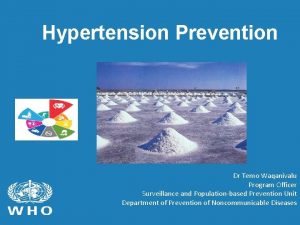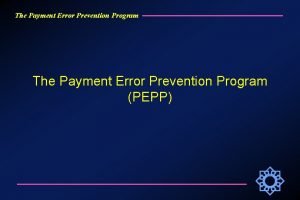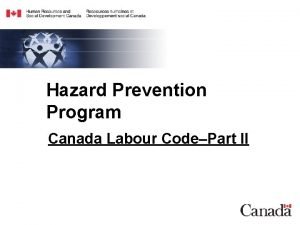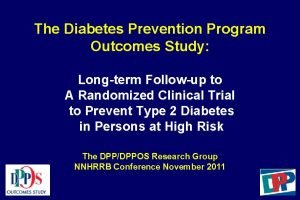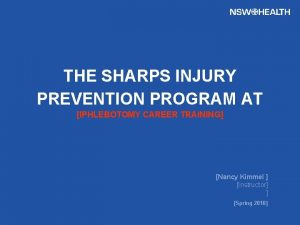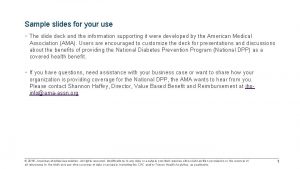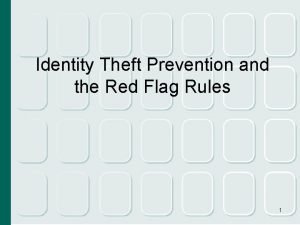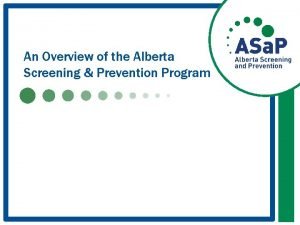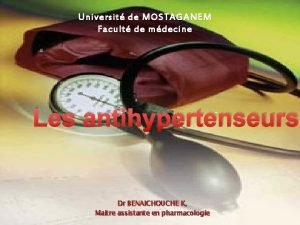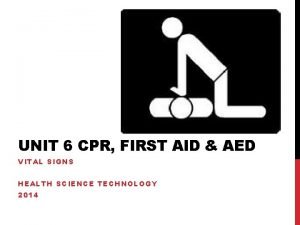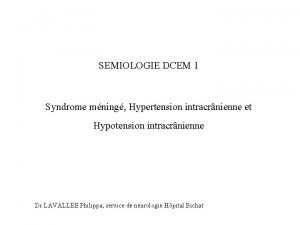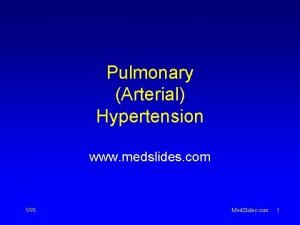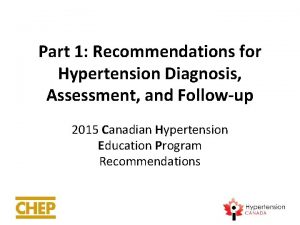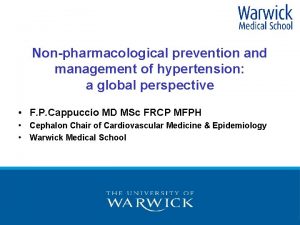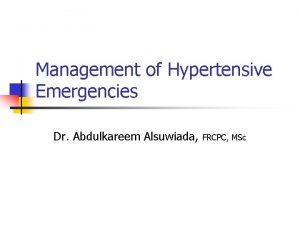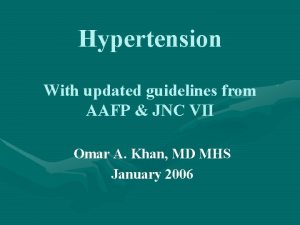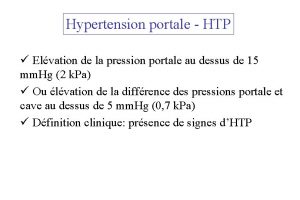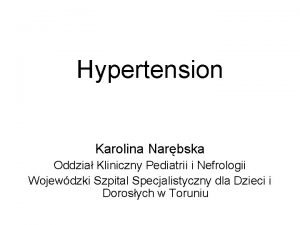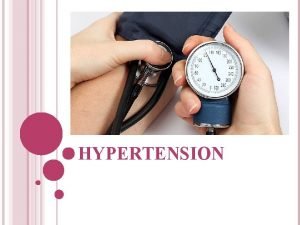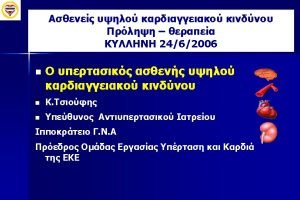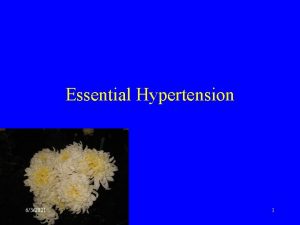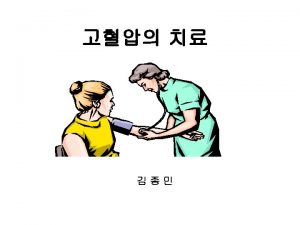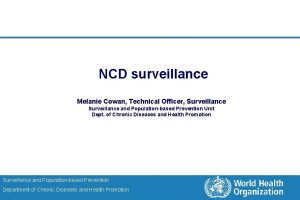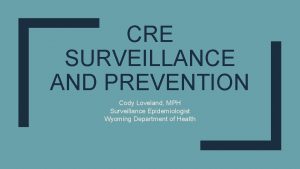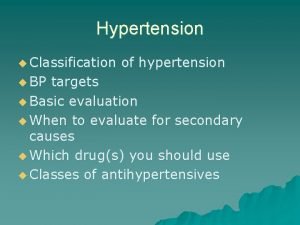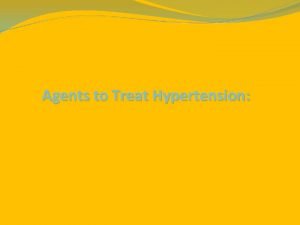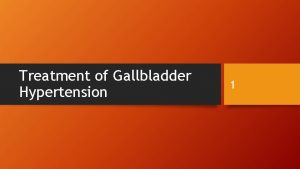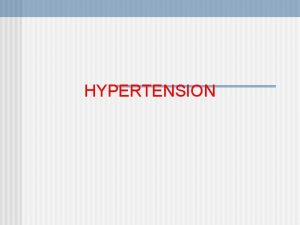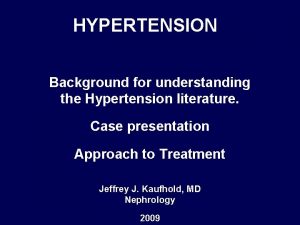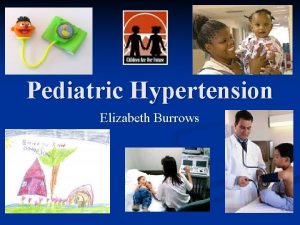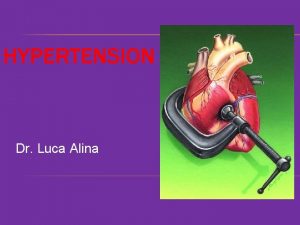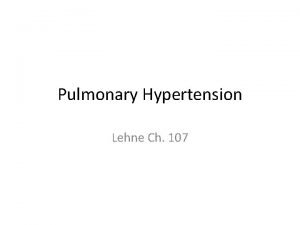Hypertension Prevention Dr Temo Waqanivalu Program Officer Surveillance































- Slides: 31

Hypertension Prevention Dr Temo Waqanivalu Program Officer Surveillance and Population-based Prevention Unit Department of Prevention of Noncommunicable Diseases

Deaths in 2011 Burden of NCD - In 2012 38 million deaths were due to NCD 25, 000 10% 20, 000 Communicable, maternal, perinatal and nutritional conditions 15, 000 Noncommunicable diseases 10, 000 Injuries 5, 000 0 0 -29 30 -69 Age groups 70 -80+ Source: WHO Global Burden of Disease (2011)

Burden of NCD

Prevalence of Raised Blood Pressure

Prevalence of Raised Blood Pressure

Causative or Contributing Factors

Source: WHO's report on "Global health risks" Leading risk factors for global mortality

Strong evidence for the link between salt and health Primarily linked with CVD – Sodium consumption increases BP – BP increases CVD risk – Age, sex and baseline BP specific effects. Source: He et al. J Human Hypertension, 2008

Dose Response: Meta-analysis (1 month or longer) Change in Systolic BP (mm. Hg) Normotensives b=0. 04, P<0. 001 Hypertensives b=0. 07, P<0. 001 Change in Urinary Sodium (mmol/24 h) A 6 g/day reduction in salt intake predicts a fall in SBP of: 7 mm. Hg in Hypertensives (p<0. 001) 4 mm. Hg in Normotensives (p<0. 01) Avg. 5 mm. Hg J Human Hypertens 2002; 16: 761

Salt Consumption Mean Sodium Intake in persons 20 yrs and over 2010 Average 10 g/day • 80% from processed foods •

Salt intake 5 -6 g/day Stroke 24% Western Pacific CHD 18% 600, 000 (approx) Stroke & heart attack deaths prevented / year Worldwide 2. 0 million (approx) deaths prevented / year He & Mac. Gregor. Hypertension 2003; 42: 1093 -99

The Political Declaration of the High Level Meeting Article 43


WHO supports countries in addressing NCDs 2000 2003 WHO Global Strategy for the Prevention and Control of NCDs WHO Framework Convention on Tobacco Control WHO Global Strategy on Diet, Physical Activity and Health WHO Global NCD Action Plan 2008 -2013 2004 WHO Global Strategy to Reduce the Harmful Use of Alcohol 2008 First WHO Global Status Report on NCDs 2009 2010 2011 Moscow Declaration 2011 UN Political Declaration on NCDs 2013 2014 2015 2014 UN Outcome Document on NCDs Country Framework for Action to engage sectors beyond health on NCDs UN Task Force on NCDs WHO Global NCD Action Plan 20132020, including 9 global targets Adoption of the post-2015 development agenda 2025 Attainment of the 9 global targets for NCDs by 2025 2030 Attainment of the global target for NCDs by 2030 (as part of the Sustainable Development Goals) World Health Assembly UN General Assembly ECOSOC

The WHO Global NCD Action Plan 2013 -2020 – six objectives 15

The Approach

Source: Rose G. “Sick Individuals and Sick Populations” IJE 2001; 30: 427 -432 High risk and Population-based approaches High-Risk Approach Population Approach Benefit is high for… The individual The whole population Subject motivation High Low Doctor motivation High Low Benefit-risk ratio “Favourable” “Worrisome” Screening costs High No screening costs Depth of solution Palliative, temporary Radical Behaviour-Context fit “Inappropriate” “Appropriate”

Very Cost Effective (Best Buy) Intervention

Causes of Causes/Determinants Development? ENVIRONMENTAL Socio-cultural Ø Economic & Trade Ø Physical Ø • 5000 yrs ago average world intake of salt 0. 1 g/day • To preserve food and clean bad ones • Development result in refrigeration and chemicals • Now 9 -12 g/day

Guidelines

SALT (Sodium) Guidelines • For adults: WHO recommends that adults consume less than 5 g (just under a teaspoon) of salt per day. • For children: WHO recommends that the recommended maximum intake of salt for adults be adjusted downward for children aged two to 15 years based on their energy requirements relative to those of adults. • All salt that is consumed should be iodized or “fortified” with iodine

HO W W HA T Population Salt Reduction Strategies INDUSTRY ACTION Product Reformulation Food Regulations O U T C O ME 3 2 1 EMPOWER CONSUMERS SUPPORTIVE SETTINGS Consumer Education Local Policies Marketing & Mobilization Catering Guidelines Reduction of salt in processed foods Reduction of use and consumption of salt Reduction of use of salt Industry Commitment • Food Targets/Standards • Proper labeling • Fiscal Measures • Public Awareness and • education campaign Behavior Change campaign Health Literacy • Food outlets Events and functions Settings (Schools, Health Care Facilities) • http: //www. who. int/dietphysicalactivity/reducingsalt/en/ -

Hidden Salt in food e. g. processed, fast, takeaway, restaurant food Food industry slowly reduce - No rejection by public Fantastic for Public Health Very little cost ↓ BP No need to change diet

How not to ↓ salt ! Give choice of reduced salt products No effect on salt intake • Allow industry to claim no one wants it • Does not target most deprived • Allow some health charities to get money from food industry! •

M&E Framework

Population Based Prevention in country • Establish Baseline level of risk and set national targets • Develop national multisectoral plans with other sectors including private and CSOs • Implement equitable actions focused on poor and vulnerable • Monitor implementation and trends • Networking

Progress so far. . • All regions except Africa are conducting surveys and initiating salt reduction measures • All regions are progressing Physical activity promotion since the global target set • Marketing Restrictions and dietary fiscal policies poorly implemented by all • Fruits and vegetable promotion to be strengthened through Nutrition Decade of Action (ICN 2) • MORE NEEDS TO BE DONE

The WHO Global NCD Action Plan 2013 -2020 – six objectives with recommended actions for Member States, international partners and WHO Action for Secretariat (WHO) • LEADING & CONVENING: Work with the United Nations funds, programs and agencies to reduce modifiable risk factors at the country level • POLICY ADVICE & DIALOGUE: Publish and disseminate guidance (“toolkits”) on the implementation and evaluation of interventions at the country level for reducing the prevalence of tobacco use, promoting a health diet and physical activity and reducing the harmful use of alcohol • NORMS & STANDARDS: continue to build on existing efforts and develop normative guidance and technical tools to support the implementation of WHO’s global strategies for addressing modifiable risk factors; • KNOWLEDGE GENERATION: Strengthen the evidence base and disseminate evidence to support policy interventions at the country level for reducing the prevalence of tobacco use, promoting a healthy diet and physical activity and reducing the harmful use • TECHNICAL COOPERATION: Provide technical assistance to reduce modifiable risk factors including through implementing the WHO guidelines and global strategies for addressing modifiable risk factors and other healthpromoting policy options. 28

S trategy development A ction to reduce salt L ink to Iodine Fortification T racking progress Toolkit

HO W W HA T Population Salt Reduction Strategies INDUSTRY ACTION Product Reformulation Food Regulations O U T C O ME 3 2 1 EMPOWER CONSUMERS SUPPORTIVE SETTINGS Consumer Education Local Policies Marketing & Mobilization Catering Guidelines Reduction of salt in processed foods Reduction of use and consumption of salt Reduction of use of salt Industry Commitment • Food Targets/Standards • Proper labeling • Fiscal Measures • Public Awareness and • education campaign Behavior Change campaign Health Literacy • Food outlets Events and functions Settings (Schools, Health Care Facilities) • http: //www. who. int/dietphysicalactivity/reducingsalt/en/ -

Thank You http: //www. who. int/dietphysicalactivity/reducingsalt/en. E mail: waqanivalut@who. int
 Temo waqanivalu
Temo waqanivalu Primary prevention secondary prevention tertiary prevention
Primary prevention secondary prevention tertiary prevention Aefi surveillance officer
Aefi surveillance officer No poder de cristo mestre
No poder de cristo mestre Aunque camine por sendas oscuras nada temo
Aunque camine por sendas oscuras nada temo Vivir subjunctive
Vivir subjunctive Navy ssop
Navy ssop Strategic sealift officer program
Strategic sealift officer program Nuclear propulsion officer salary
Nuclear propulsion officer salary Payment error prevention program
Payment error prevention program Kansas eviction prevention program 2021
Kansas eviction prevention program 2021 Hazard prevention program
Hazard prevention program Diabetes prevention program outcomes study
Diabetes prevention program outcomes study Sharps injury prevention program
Sharps injury prevention program Diabetes prevention program ppt
Diabetes prevention program ppt Identity theft prevention program
Identity theft prevention program Counterfeit parts prevention program as5553
Counterfeit parts prevention program as5553 Alberta screening and prevention program
Alberta screening and prevention program Hypertension artérielle
Hypertension artérielle Vital signs cpr
Vital signs cpr Hypertension
Hypertension Jnc 7 hypertension
Jnc 7 hypertension Syndrome méningé
Syndrome méningé Medslide
Medslide Hypertension
Hypertension Equivalence hbpm
Equivalence hbpm Hypertension
Hypertension Hypertensive urgency vs emergency
Hypertensive urgency vs emergency Demadex
Demadex Signe de cruveilhier baumgarten
Signe de cruveilhier baumgarten Stage 1 hypertension
Stage 1 hypertension Modifiable risk factors for hypertension
Modifiable risk factors for hypertension
